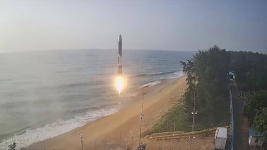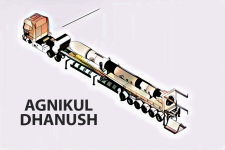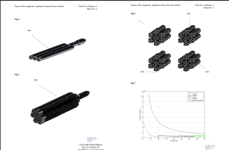Centre to support Agnikul Cosmos in developing Agnibaan rocket
India Today Science Desk, New Delhi
UPDATED: Dec 17, 2024; 16:17 IST
This funding will facilitate the creation of the launch vehicle that meets diverse mission requirements while reducing lead times for satellite launches to just two weeks.

Agnibaan launching on Sorted-1 mission. (Photo: Agnikul).
In Short:
This highly customizable two-stage rocket is designed to deliver payloads of up to 300 kg to orbits at an altitude of 700 km, aiming to make satellite launches more accessible and affordable.
The initiative is backed by the Technology Development Board (TDB), which has sanctioned financial assistance for the project titled "Development and Commercialization of Modular Configurable Launch Vehicle for 100 Kg Payload."

This funding will facilitate the creation of a launch vehicle that meets diverse mission requirements while reducing lead times for satellite launches to just two weeks.
Agnikul Cosmos, incubated at IIT-Madras and guided by a team of 45 former ISRO scientists, achieved a historic milestone earlier this year with the successful launch of Agnibaan SOrTeD, the world's first rocket powered by a single-piece 3D-printed engine.
The Agnibaan vehicle is poised to revolutionize the satellite launch ecosystem by offering dedicated launches and operational flexibility through mobile launch systems that can be deployed globally.
Agnikul aims to revolutionize satellite launches with its Agnibaan rocket by reducing lead times for satellite launches to as little as two weeks, offering operational flexibility through mobile launch systems that can be deployed globally, and enabling customizable space missions for small satellites, eliminating the inefficiencies of traditional rideshare models.

The Agnibaan project incorporates several cutting-edge technologies, including India's first single-piece 3D-printed rocket engine and mobile launch platforms capable of launching from various locations.
The startup has developed all major subsystems in-house, ensuring comprehensive testing facilities for quality assurance and subsystem evaluations.
With its innovative approach, Agnikul aims to democratize access to space, catering to the growing demand for small satellite launches.
Centre to support Agnikul Cosmos in developing Agnibaan rocket
India Today Science Desk, New Delhi
UPDATED: Dec 17, 2024; 16:17 IST
This funding will facilitate the creation of the launch vehicle that meets diverse mission requirements while reducing lead times for satellite launches to just two weeks.

Agnibaan launching on Sorted-1 mission. (Photo: Agnikul).
In Short:
- The initiative is backed by the Technology Development Board
- Agnikul Cosmos was incubated at IIT-Madras
- The Agnibaan vehicle aims to revolutionise the satellite launch ecosystem
This highly customizable two-stage rocket is designed to deliver payloads of up to 300 kg to orbits at an altitude of 700 km, aiming to make satellite launches more accessible and affordable.
The initiative is backed by the Technology Development Board (TDB), which has sanctioned financial assistance for the project titled "Development and Commercialization of Modular Configurable Launch Vehicle for 100 Kg Payload."

This funding will facilitate the creation of a launch vehicle that meets diverse mission requirements while reducing lead times for satellite launches to just two weeks.
Agnikul Cosmos, incubated at IIT-Madras and guided by a team of 45 former ISRO scientists, achieved a historic milestone earlier this year with the successful launch of Agnibaan SOrTeD, the world's first rocket powered by a single-piece 3D-printed engine.
The Agnibaan vehicle is poised to revolutionize the satellite launch ecosystem by offering dedicated launches and operational flexibility through mobile launch systems that can be deployed globally.
Agnikul aims to revolutionize satellite launches with its Agnibaan rocket by reducing lead times for satellite launches to as little as two weeks, offering operational flexibility through mobile launch systems that can be deployed globally, and enabling customizable space missions for small satellites, eliminating the inefficiencies of traditional rideshare models.

The Agnibaan project incorporates several cutting-edge technologies, including India's first single-piece 3D-printed rocket engine and mobile launch platforms capable of launching from various locations.
The startup has developed all major subsystems in-house, ensuring comprehensive testing facilities for quality assurance and subsystem evaluations.
With its innovative approach, Agnikul aims to democratize access to space, catering to the growing demand for small satellite launches.
Centre to support Agnikul Cosmos in developing Agnibaan rocket







































